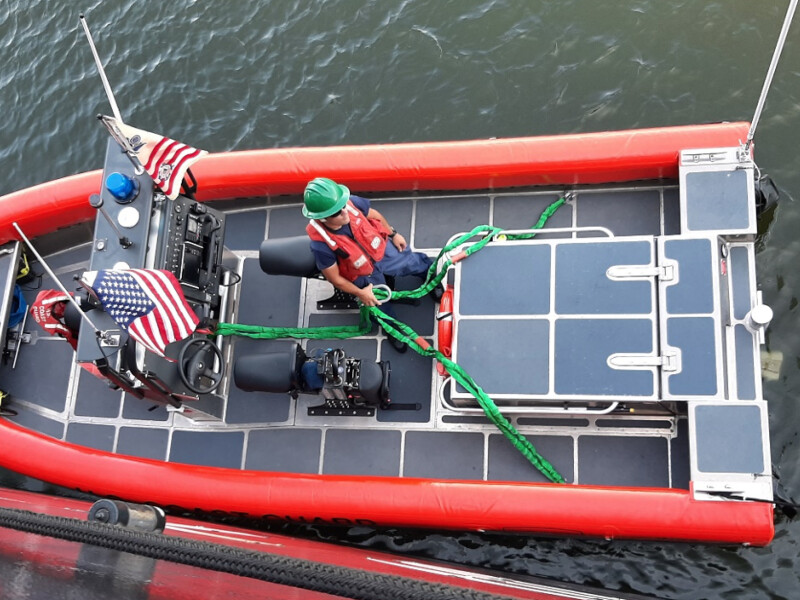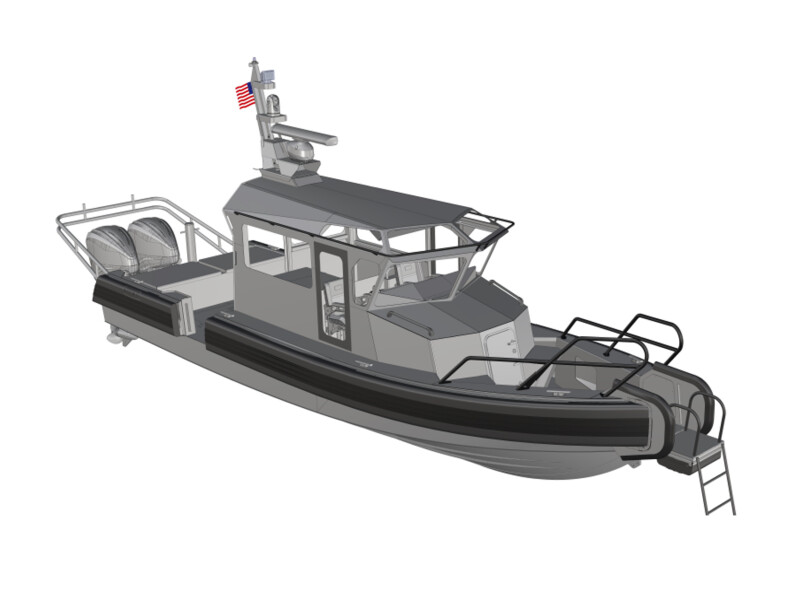North River Boats, Roseburg, Ore., delivered a 30'×10' patrol boat to the Washington Department of Fish and Wildlife (WDFW) last August. It mainly works the waters of Puget Sound with a two-man crew.
“We are one of the largest suppliers for Washington Fish and Wildlife,” said Mike Blocher, director of sales for North River Boats. “Depending on the area and the operator, they will choose the platform that works best for them.”
Thus the 30-footer is operating in the relatively protected waters of Puget Sound, whereas a larger 38-footer that North River will deliver soon to the WDFW will work offshore.
The 30-footer is powered with twin 300-hp Yamaha 4.2L four-stroke outboards that propel the patrol boat to 50 mph. The outboards are controlled with Yamaha Helm Master joystick controls.
At full throttle or when idling, the crew operates from within a walk-around pilothouse that features All Salt Maritime’s Shoxs 6300 shock-mitigating seats. Inside the wheelhouse is a dinette with a small galley and a bathroom.
An Imtra Sleipner (Side-Power) bowthruster helps when maneuvering in tight quarters or sidling up to larger vessels. Going against larger boats explains the bumpers on the side of the hull instead of a foam or rubber collar. For rescue work, there’s a davit on the back deck, as well as a ladder leading from the water over the transom.
METALCRAFT
MetalCraft Marine is currently building three patrol boats and recently delivered three others. Two of the three boats under construction will go to Lake Erie for the Ohio Department of Natural Resources (DNR), while the third will patrol out of Corpus Christi, Texas, for the Port of Corpus Christi Police. The three recently delivered boats went to Pensacola, Fla., and the Coast Guard in mid-February.

The Coast Guard boats are all Interceptor seven-meter (22'6"×8'3") RIBs with Wing foam collars, which “is the most popular size worldwide with navies, coast guards,” said Bob Clark, MetalCraft Marine’s contract manager. The company will deliver 15 more boats to the Coast Guard this year. Some are going to Alaska and some to California and Washington. Another 18 will be built in 2023 and 15 in 2024.
Designated cutter-boat-large, the boats will be carried aboard Coast Guard vessels and be used for search and rescue, drug interdiction, and crew transfers. Seven-meter Interceptors were chosen because they will be placed on older vessels and older Coast Guard and Navy ships that were designed to carry similar-sized boats. Also, the vessel’s davits were built for the 4,300-lb. weight of a seven-meter boat.
The new RIBs are being powered with a single Volvo Penta D-3 diesel, matched up with a duoprop outdrive designed to give the RIBs a top speed of 38 knots. Shoxs impact-mitigating suspension seats should make the ride at that speed a lot easier on the crew.
Weight was also a factor in the selection of the Volvo engines, “because Volvo is lighter. Cummins weighs so much more,” said Clark. Though “the Navy uses Cummins diesels in all their seven-meter RIBS.”

The two boats going to Lake Erie for the Ohio DNR are an eight-meter Interceptor (26'6"×8'5.5") and 10-meter Interceptor (34'×9'10"). Their primary mission will be patrol and search and rescue work, and, when needed, back up support for the U.S. Customs and Border Protection, Coast Guard, and municipal activities.
Clark described Lake Erie as the “roughest body of water in the Great Lakes. Maybe one of the roughest bodies of water in North America, with the deepest part only 100 feet, most of it 30 feet.” With a good amount of wind, that could make for very rough, uncomfortable passages.
“It’s the hull shape and then seats,” said Clark, that ensure the crew’s comfort in the worst situations. He describes the eight-meter hull “as really beefy, heavy and with a really fine bow entry.” When developing the hull, MetalCraft put the design through 18 design iterations. Then after the first hull was built the design was tweaked once more, mainly in the width of the chine. The final hull shape, plus two bulkhead-mounted Shoxs impact-mitigating suspension seats, should give the advantage to the patrol boat when looking for the bad guys.
In fact, if you are one of the bad guys that the Ohio DNR is after, you better have efficient hulls and a lot of horsepower because both DNR boats will be powered with Yamaha outboards capable of top speeds in the 50-knot range. The eight-meter Interceptor will have a pair of Yamaha 300-hp outboards, while the larger 10-meter Interceptor will hit 50 knots with two 425-hp outboards.
A feature on the Lake Erie boats Clark calls “a revolutionary change for RIBs” is the bow ramp. MetalCraft puts them in landing craft boats “but in high-performance RIBS it’s not done.” Yet, as he points out when someone needs to go ashore, it’s much easier to get there via a bow ramp than crawling over the bow or jumping in the water.
The two Lake Erie boats are just the start of MetalCraft’s three-year contract with the Ohio DNR. “It could be 20-plus boats,” said Clark. “What we are trying to do is find the perfect boat for Lake Erie.”
The patrol boat for Corpus Christi is 42'6"×13'4", a multimission policing and security, ship escort and search and rescue vessel. It is also the same model that won WorkBoat’s 2020 Boat of the Year Award after it was built for the Los Angeles Port Police.
The 43-footer is expected to be running “long shifts, 24/7,” Clark said in an email, and he “anticipates 2,500 to 2,800 operating hours per year.” Power for those long patrols is supplied by a pair of 600-hp Cummins 8.3L engines, matched up to HamiltonJet 322 waterjets through ZF marine gears that should generate 38 knots when the patrol boat is fully loaded.




